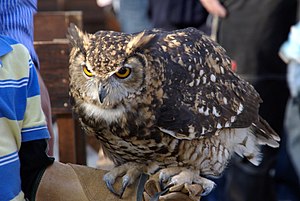Kapuhu
| Kapuhu | ||||||||||
|---|---|---|---|---|---|---|---|---|---|---|

Kapuhu ( Bubo capensis ) |
||||||||||
| Systematics | ||||||||||
|
||||||||||
| Scientific name | ||||||||||
| Bubo capensis | ||||||||||
| Smith , 1834 |
The Kapuhu ( Bubo capensis ), sometimes also spelled Cape Eagle Owl, is a species from the family of real owls. It has a disjoint distribution area in Africa.
features
The Kapuhu is a relatively large species of owl and reaches a body length of 46 to 58 centimeters. He has showy feather ears, the eyes are yellow to orange in color. The chest is heavily spotted on the sides. The legs and toes are densely feathered. It is very similar to the Fleckenuhu . However, this is smaller and has stains and horizontal stripes on the underside of the body. The gray owl , which is also smaller, has stripes on the underside of the body. He also has rather brownish eyes.
distribution and habitat
The distribution area of the cape is eastern and South Africa from Eritrea and Ethiopia to Kenya , Tanzania , Zimbabwe , Mozambique , the Cape Province in South Africa and southern Namibia . However, this area is not continuously populated. The habitat of the Kapuhus is predominantly mountainous and hilly landscapes with rocky areas or rocky gorges. However, it also occurs in the rather flat Karroo in the Cape Province and also hunts in open savannas. In individual regions it has also opened up human habitat and broadcasts in cities, where it hunts city pigeons at dusk.
Way of life
The Kapuhu is basically a crepuscular and nocturnal owl, but can occasionally also be observed after sunset or before sunset. It transmits in crevices and similar caves and occasionally even on the ground under a bush. Males and females often transmit together. This is especially true for the time immediately before the start of the reproductive period.
The food spectrum consists of small rodents up to the size of rabbits and birds up to the size of a hammer head . It also eats lizards, frogs, scorpions, crabs and larger insects. The daily food requirement is estimated at 650 to 750 grams.
The Kapuhu is a distinctly territorial owl. In regions densely populated by capeulen, the districts occasionally only have a size of 2.5 square kilometers. The Kapuhu is very adaptable in the choice of nesting place. Places under a ledge, abandoned nests of larger birds, but also on the ground under a bush are used as nesting sites. A nest is not built; at best, capuhus scratch a shallow nesting trough. They raise a maximum of one clutch per year. Occasionally, pairs only breed every other year. The clutch usually consists of two white eggs. The female breeds alone. The breeding season is 34 to 38 days. During this time she is provided with food by the male. The nestlings are also huddled by the female alone. Only when these have reached an age of around 17 days does the female occasionally leave them to go hunting. The young birds can fledge at 70 to 77 days, but remain in the family until they are around six months old. They achieve their reproductive ability in the second year of life.
Subspecies
There are three known subspecies:
- Bubo capensis capensis Smith, A, 1834 occurs in South Africa and southern Namibia .
- Bubo capensis dillonii Des Murs & Prevost , 1846 occurs in Ethiopia and Eritrea .
- Bubo capensis mackinderi Sharpe , 1899 is distributed from Kenya to western Mozambique .
The latter is sometimes understood as a separate species and then called Bubo mackinderi .
supporting documents
Single receipts
- ↑ a b König et al., P. 328
- ↑ König et al., S: 329
- ^ IOC World Bird List Owls
- ^ Andrew Smith (1834), p. 317
- ^ Marc Athanase Parfait Œillet Des Murs (1846) u. a., p. 242
- ^ Richard Bowdler Sharpe (1899), p. 28
- ↑ Bubo mackinderi on avibase.bsc-eoc.org
literature
- Claus König , Friedhelm Weick: Owls of the World . Christopher Helm, London 2008, ISBN 978-0-7136-6548-2
- Andrew Smith: African Zoology . In: South African quarterly journal . tape 2 , no. 3 , 1834, pp. 305-320 ( biodiversitylibrary.org ).
- Marc Athanase Parfait Œillet Des Murs, Florent Prévost: Description d'une nouvelle espèce d'oiseaux de Madagascar, du genre Philépitte, et de trois nouvelles espèces d'Abyssinie . In: Revue zoologique . tape 9 , 1946, pp. 241-243 ( biodiversitylibrary.org ).
- Richard Bowdler Sharpe: Dr. Bowdler Sharpe described as new the following species of African birds . In: Bulletin of the British Ornithologists' Club . tape 10 , no. 67 , 1999, pp. 27-28 ( biodiversitylibrary.org ).
Web links
- Bubo capensis inthe IUCN 2013 Red List of Threatened Species . Listed by: BirdLife International, 2012. Retrieved February 6, 2014.

